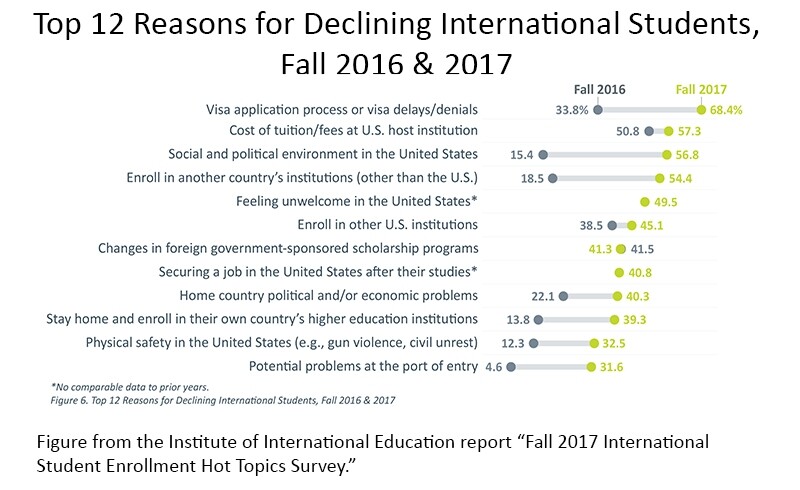
US Physics Doctoral Programs See Precipitous Drop in International Applications
The number of international students applying to U.S. physics Ph.D. programs fell by an average of 12 percent from 2017 to 2018, according to new data from a survey conducted by the American Physical Society, an AIP Member Society.
APS staff decided to conduct the survey after hearing about large drops in the number of applications at the society’s annual meeting in March, APS Chief Government Affairs Officer Francis Slakey told FYI. “As the results came in, we realized that the problem was widespread. I checked with colleagues from other professional societies and found that they were seeing similar alarming drops,” Slakey said.
The findings follow reports
Smaller physics programs see largest application declines
APS sent the survey in April to department chairs of 74 U.S. physics Ph.D. programs that graduate 10 or more students per year. Institutions were asked to report the number of international applications they received in fall 2017 and fall 2018. A total of 49 institutions responded, including 15 private and 34 public institutions. Of the responses received, 13 institutions reported application decreases greater than 20 percent. Only seven programs reported increases. The full survey is confidential, but APS has allowed FYI to report certain summary statistics.
Larger programs, as measured by number of graduate students applying, reported significantly smaller decreases. Programs that received over 200 international applications in 2017 saw an average 6 percent decrease, whereas those receiving fewer than 100 international applications in 2017 observed an average 20 percent decrease. Not all responding institutions reported the total number of applicants.
In response to the survey’s findings, APS plans to use its June Congressional Visit Days, convening in Washington this week, to talk with members of Congress and their staff about how international students contribute to the U.S. economy and to advocate visa policy changes that would incentivize students to come to the U.S. and remain after graduation.
International PhD applications, enrollment for major institutions steady since 2005
Whether the large drop in the number of international applications to some Ph.D. physics programs will affect their enrollment levels is not clear. According to the AIP Statistical Research Center (SRC), U.S. physics Ph.D. programs have had relatively stable international first-time enrollment rates since 2005, as shown in the following chart.

International student enrollment in U.S. physics Ph.D. programs steadily increased in the 1970s through the early 1990s. After a slight dip in the mid-1990s, it continued to grow again until it outnumbered domestic student enrollment from 1997 to 2001. Then international enrollment of first-year students dropped
While data on the number of applications is not available for U.S. physics Ph.D. programs in prior years, a report

Year-over-year change in international application and first-time enrollment rates in U.S. graduate programs. The data shows that graduate international enrollment rates tend to correlate with application rates.
However, the report notes that the extent of the declines vary among programs, most strongly impacting enrollment in non-Ph.D. programs and institutions not classified as high-research activity doctoral institutions. By contrast, first-time enrollment in doctoral programs modestly grew by 1.8 percent among all institutions in 2017.
Graduate program acceptance rates and the number of international applicants who accept admission offers have remained relatively steady. The report notes this may indicate the U.S. graduate admissions process remains internationally competitive and prospective international students are still highly likely to accept admission offers from U.S. institutions.
US political environment, international competition cited as potential contributing factors
While a number of factors could be affecting international graduate student enrollment and application rates, the international application declines come at a time when President Trump has been pushing for changes
A recent survey

The top 12 factors higher education institutions cited as key factors contributing to the declines in first-time enrollment of international students in fall 2016 and 2017.
(Image credit - IIE)
The number of institutions citing concern over the visa application process increased by 35 percentage point increase between 2016 and 2017. In line with those findings, the Wall Street Journal reported
The State Department is currently working
While the Trump administration’s travel ban proposals have affected
Several U.S. graduate physics program heads suggested the rise of global competition in STEM research and education could also be contributing to recent declines. Reacting to the APS survey results, Chris Neu, director of graduate admissions in physics at the University of Virginia told FYI in an email, “The quality of international Ph.D. programs has (perhaps) increased.” He said a number of major science experiments are being considered for facilities in Asia, including “major endeavors in China and Japan in future particle accelerators.”
Warren S. Warren, physics department chair at Duke University, said the large investments that China in particular has made in laboratories and recruiting scientific talent have dramatically improved the caliber of its science. While he said Chinese students still travel abroad in large numbers to obtain graduate degrees, he predicted,
There’s every reason to believe that’s going to change over the next decade or two, simply based on the very large funding levels associated with basic science in China relative to the challenges in place [in the U.S.].


